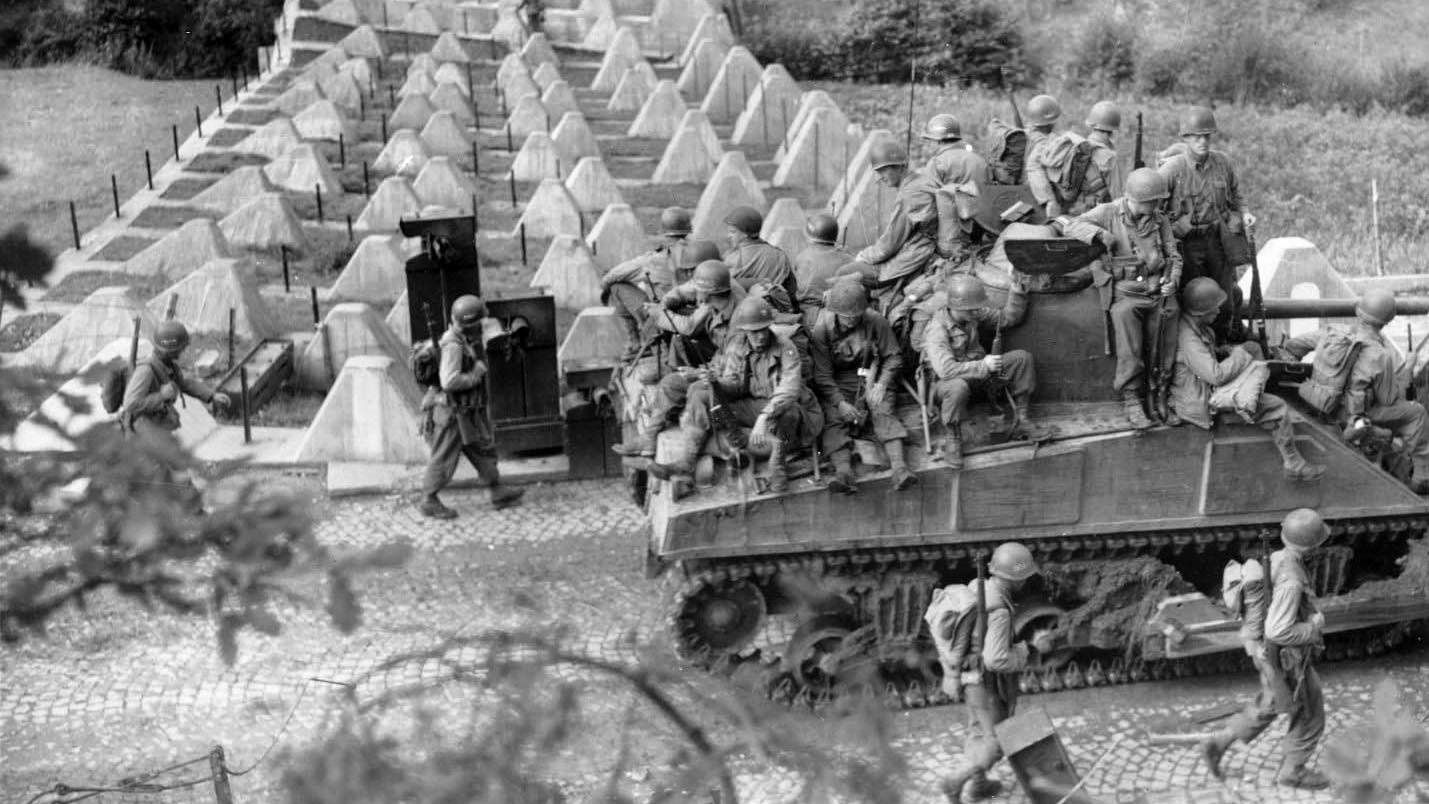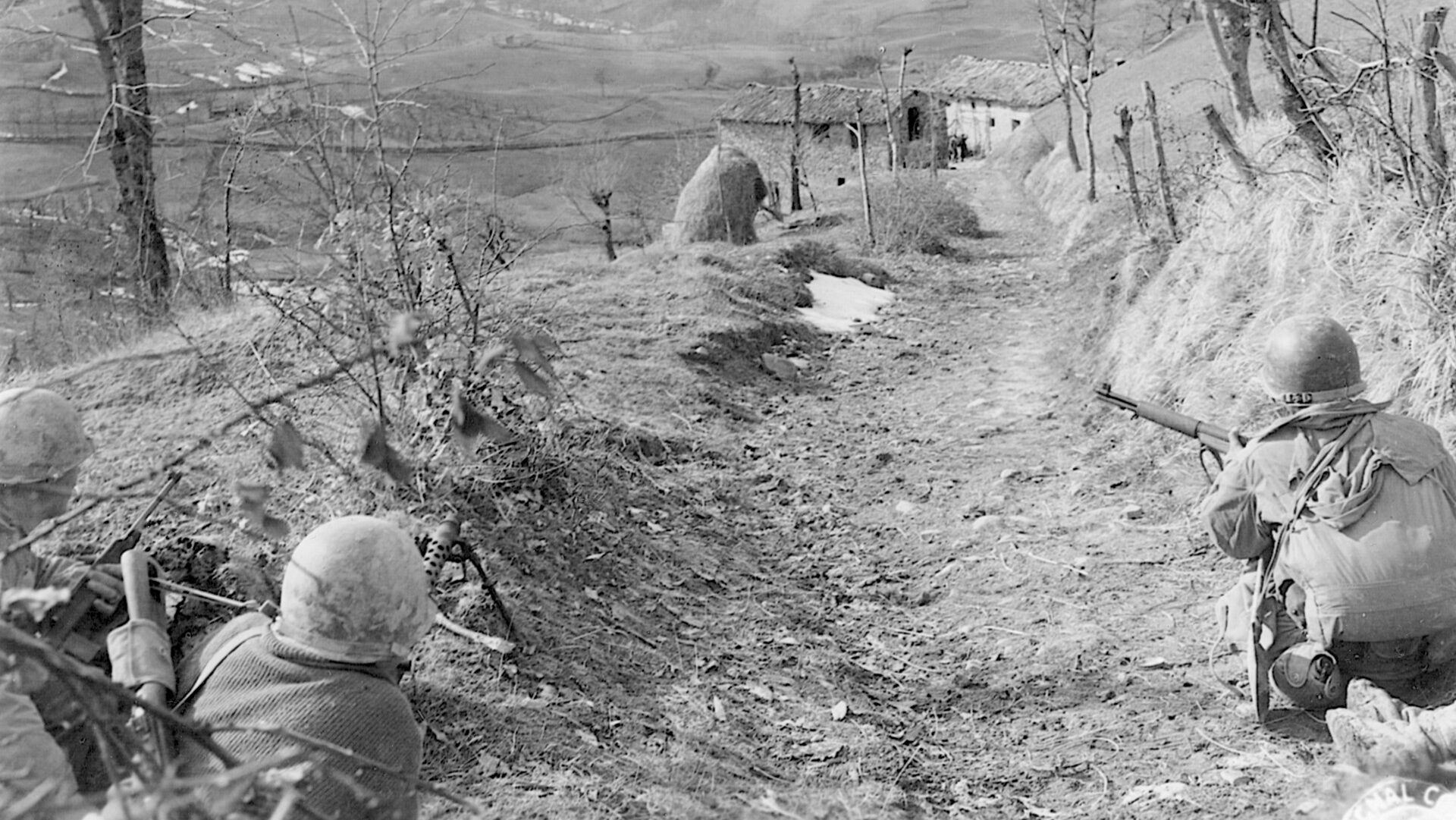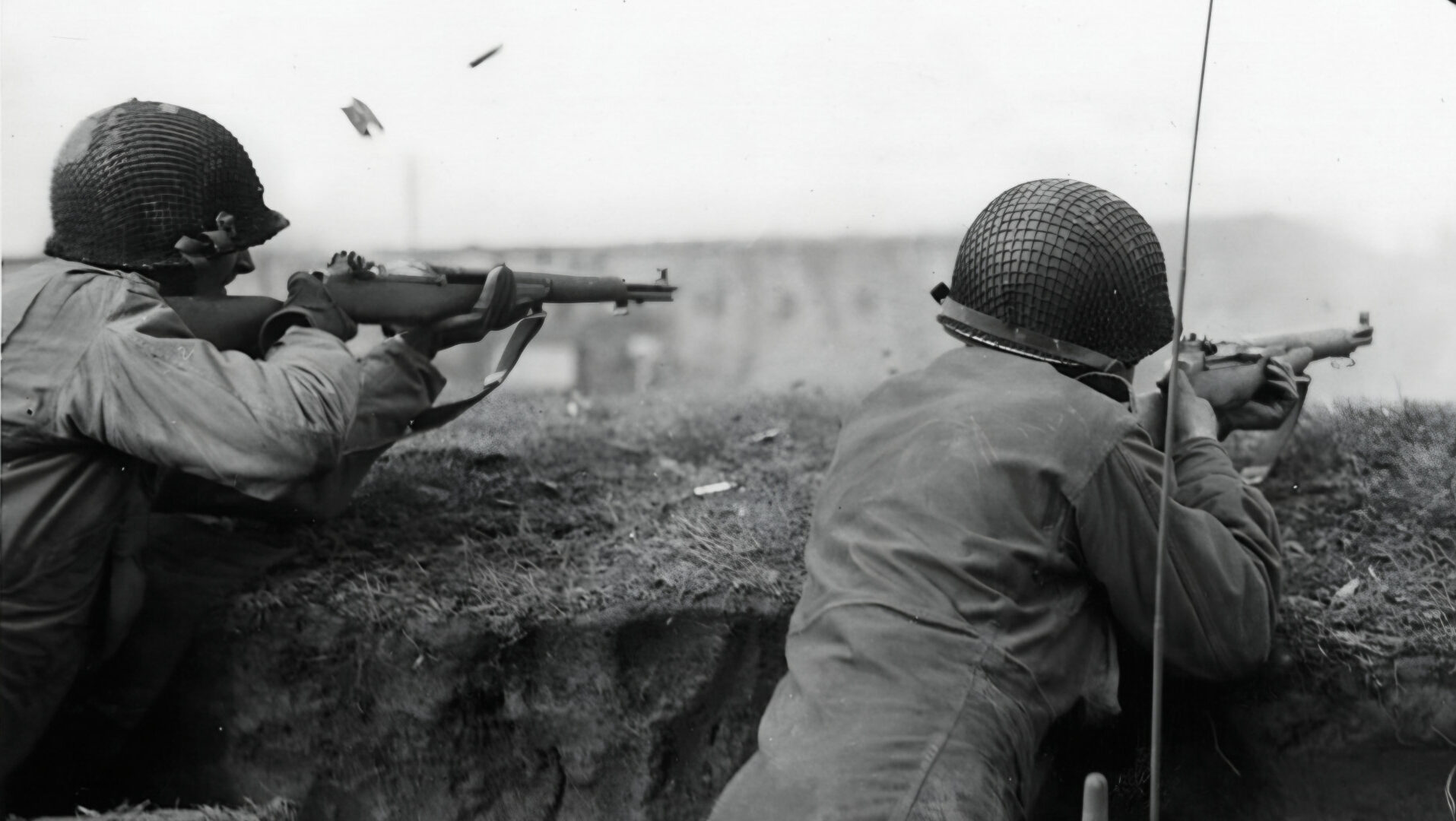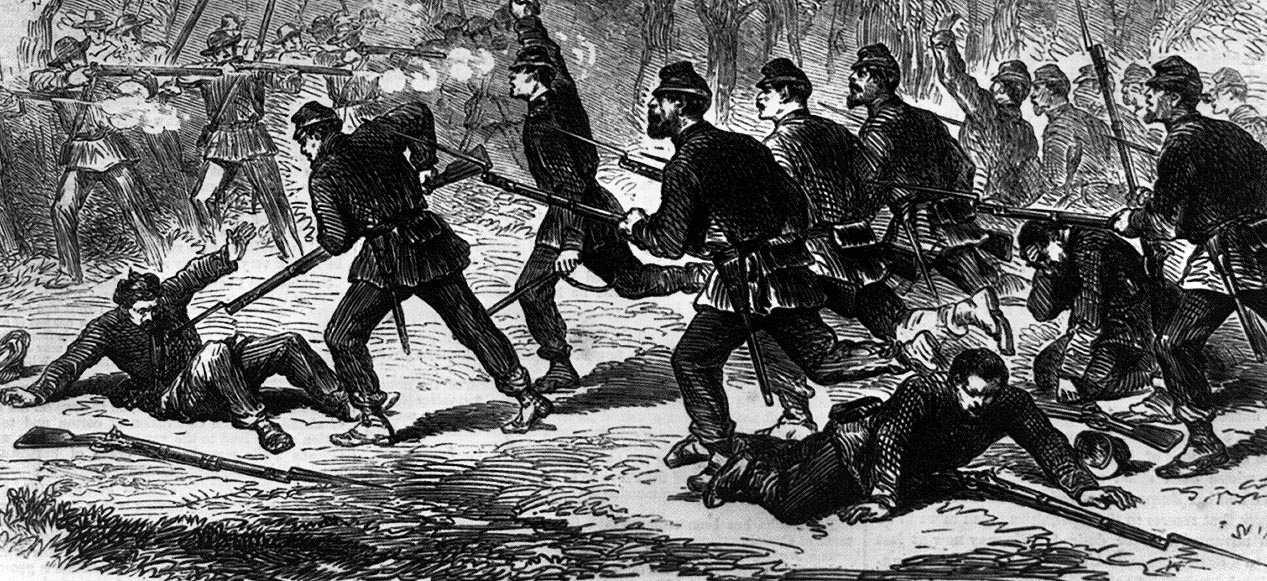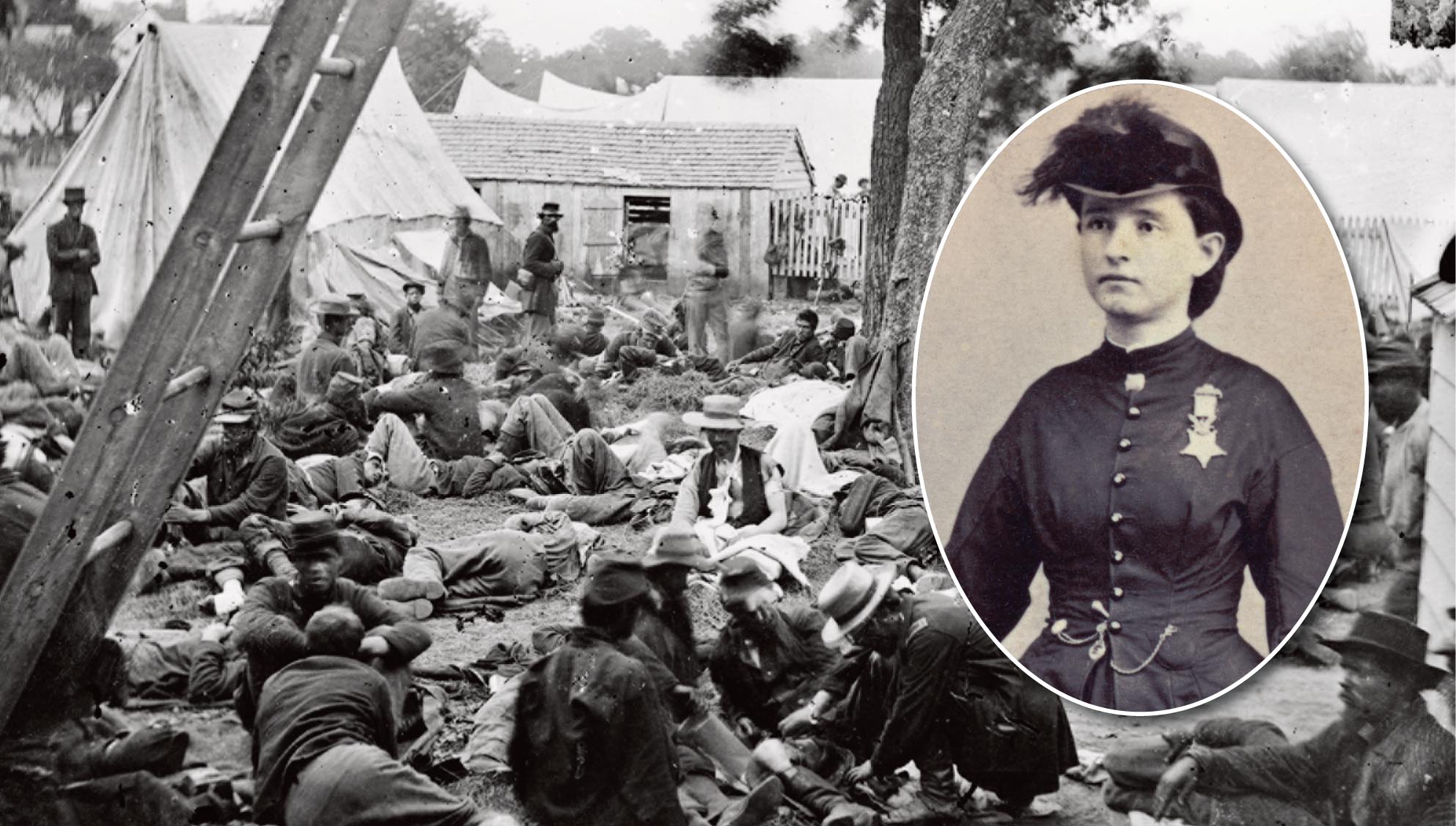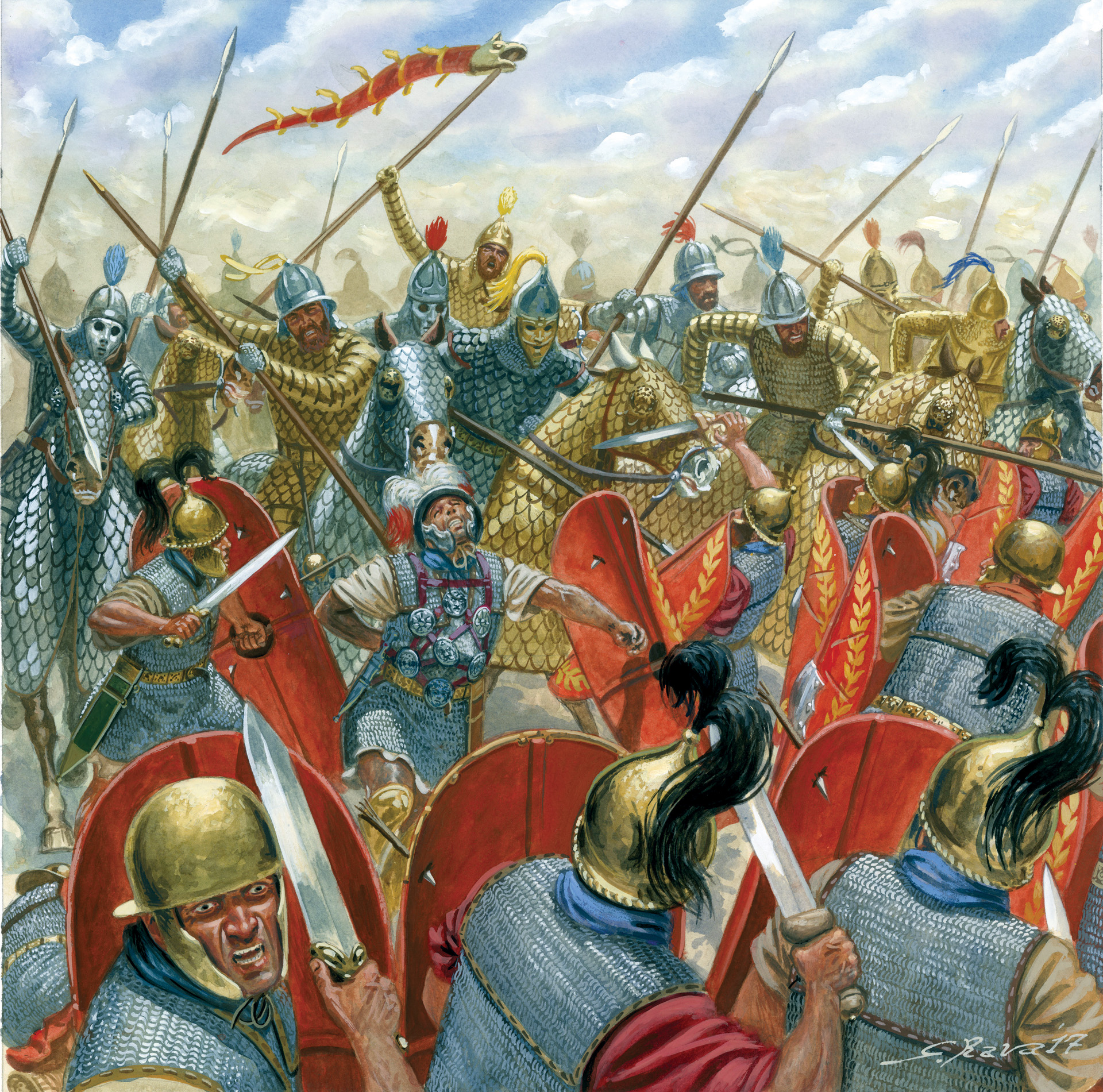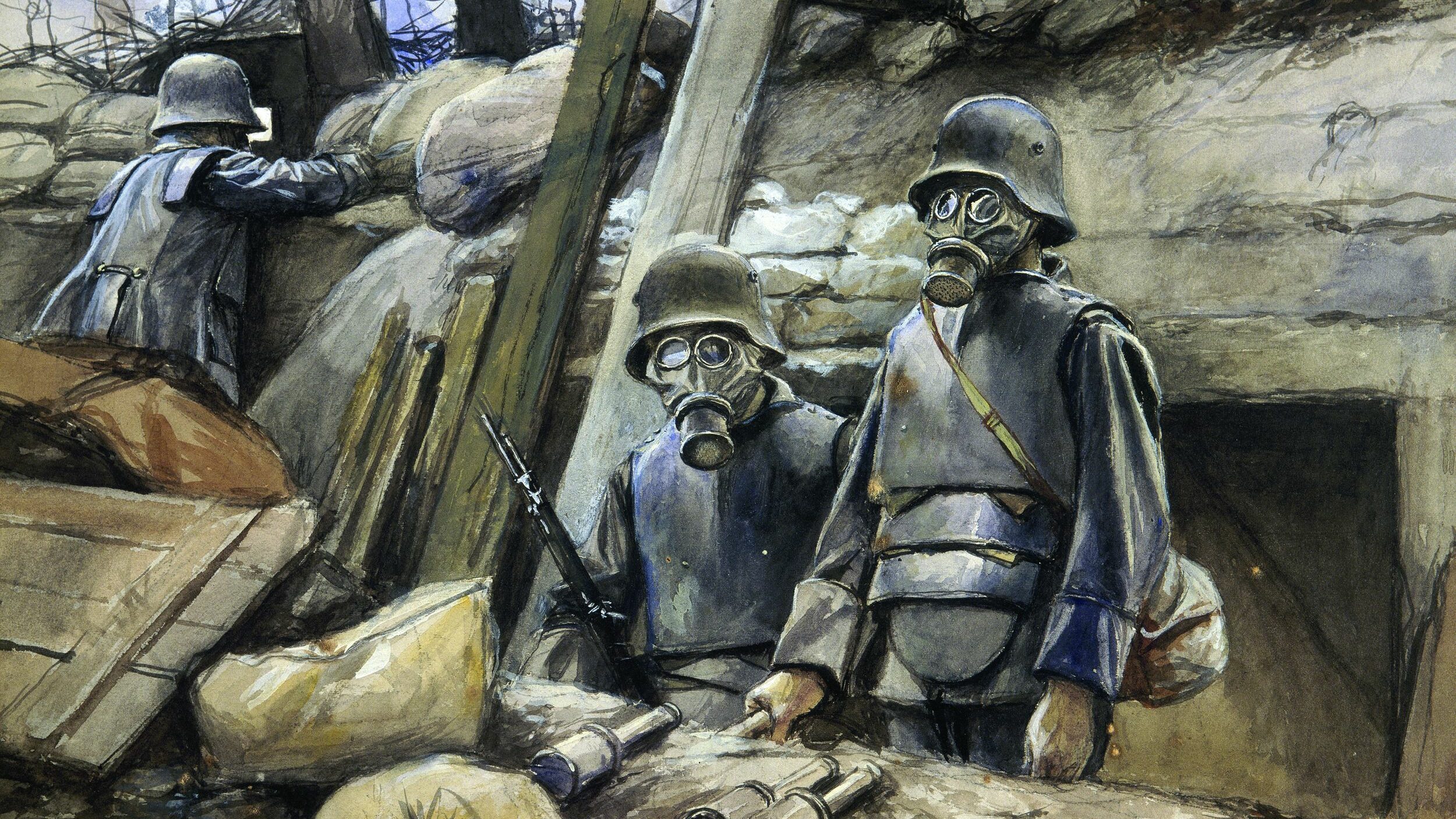By Christopher Miskimon
A column of American M-4 Sherman medium tanks moved through Dison, Belgium, in late summer 1944, near the city of Liege. The tankers belonged to Company I, 32nd Armored Regiment of the 3rd Armored Division, known by its moniker “Spearhead.” Leading the column, Staff Sergeant Lafayette Pool acted as platoon leader despite his rank as a non-commissioned officer.
It didn’t matter; Pool was trusted, and his leadership made him as good as any lieutenant in the regiment. His skill as a tanker was unquestioned by his peers; he and his crew were about to prove that again.
As the column advanced, they took fire from their left flank. Telling the column to continue, Pool ordered his own tank, the moniker “In the Mood” painted on the side of its hull, to turn and deal with the threat. Soon they located an enemy unit, no tanks but a number of other armored vehicles such as halftracks and armored cars. The Americans opened fire, destroying a half-dozen German vehicles. Their brief rampage was cut short when Pool learned a German PzKpfw V Panther medium tank had appeared ahead and fired on his column. He ordered his driver, Corporal Wilbert Richards of Cumberland, Maryland, to get back to the column. The M-4 roared ahead as the gunner, Corporal Willis Oller of Morrisonville, Illinois, prepared to engage the enemy tank.
Arriving at the scene, Pool scanned the distance for the Panther as his loader, Technician 5 Del Boggs from Lancaster, Ohio, pushed a 76mm armor-piercing round into the breech of the M-4’s main gun. Pool spotted the enemy tank and gave his gunner a distance to target of 1,500 yards. This was long range for a shot against the well-armored German vehicle, but a hit against its side armor could penetrate even at such a distance. Oller took careful aim and pressed the gun’s firing pedal with his foot. With a flash and a supersonic crack, the 76mm shot soared straight into the Panther, destroying it. Pool calmly resumed his place at the head of the column, and the advance continued. Score another success for one of the U.S. Army’s greatest tank aces.
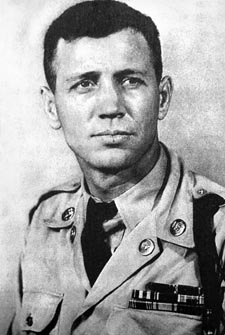
“Tank Ace” is a term use to describe tankers who enjoy great success against enemy armored vehicles. For aviators, an ace is someone who downs five enemy planes in aerial combat; no set number exists for tank aces. It is more a matter of destroying many more enemy vehicles than are shot out from under them. Also, tank aces work as part of a crew, with the title usually going to the vehicle commander, though they all share in the achievement. For World War II, many think most often of “Panzer Aces.” While many German tankers did attain impressive numbers of enemy tanks knocked out, there were also a number of tank aces on the Allied side during World War II, and Lafayette Pool was among the best.
Born in the small town of Odem, Texas, Lafayette G. Pool arrived five minutes after his twin brother John, on July 23, 1919. He graduated from Taft High School in 1937, and both brothers immediately tried to join the Navy. John was accepted but “Lafe,” as Lafayette was nicknamed, got turned away due to an old eye injury. While a young boy, Lafe had decided to make a saddle for his dog out of an old inner tube. While working away with a rusty pair of scissors, his hand slipped, and the cutting tool went into his eye, damaging the iris. While John left for the Navy, Lafe spent a year attending a Catholic prep school in Corpus Christi, graduating in 1938. Afterward, he enrolled in the Texas College of Arts and Industries, now part of the Texas A&M University system, to study engineering. To pay for his education he worked on his father’s farm and fought as a Golden Gloves boxer.
Pool’s desire to serve soon drew him away from his studies. When the United States instituted a draft in 1940, he volunteered for the Army, which took him despite the old eye injury. Pool reported to Fort Sam Houston in June 1941, and attended basic training at nearby Dodd Field before being transferred to the 40th Armored Regiment at Fort Polk, Louisiana. Soon afterward, he received another transfer to the 32nd Armored Regiment, part of the newly organized 3rd Armored Division. Initially trained as a mechanic, he became part of a tank crew and then a vehicle commander.
As the unit trained and prepared for combat, Pool’s Golden Gloves background led him to join the division team, where he soon became regional champion in his weight class. He also developed a reputation as a disciplined leader and rigorous trainer. His crew was expected to do everything the right way, from gunnery to maintenance. Pool expected the best from his crew and got it. His focus on training was so intense that he turned down a chance to go to a national boxing meet in Chicago in the spring of 1942, because the division received a shipment of the new M-4 medium tanks. Pool wanted to start training right away; boxing wouldn’t help kill Germans, so it had to wait.
During 1942 and 1943, the 3rd Armored Division went through training at the Desert Training Center near Victorville, California, and then to Fort Indiantown Gap, Pennsylvania. Shortly before the division embarked for England in September 1943, Pool received promotion to staff sergeant in Company I, Third Battalion, 32nd Armored Regiment. His leaders thought highly enough of Pool to offer him a chance to attend Officer Candidate School and receive a commission as a 2nd lieutenant, but he turned it down, just as later in Europe he refused a battlefield commission. His reason was simply stated: “I just want to have one of the best tank crews in the division.”
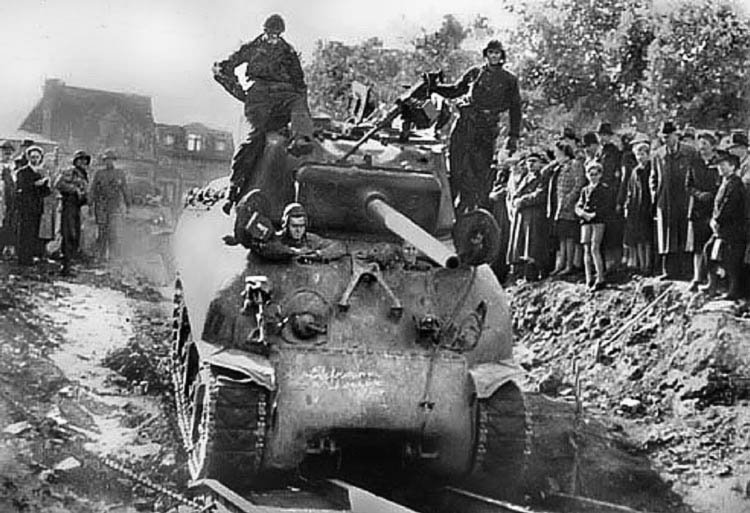
Once in England, training continued as the division prepared for the cross-Channel D-Day invasion of Europe on June 6, 1944. There were occasional diversions, and one day Pool became one of them. Joe Louis, the famous champion heavyweight boxer, toured England putting on exhibitions for the troops. Few men wanted to get into the ring with Louis, until Pool said he would. Although it was meant to be a friendly publicity bout, Pool, always competitive and driven, went a bit too far and landed several good blows on the professional boxer.
Louis simply put his arm around Pool and said, “White man, I’m going to teach you a big lesson.” Louis did everything but knock Pool out, and the young tanker later said Joe Louis turned him ‘every which way but loose’ during this “friendly” fight. Soon, however, it was time to go to war.
The division came ashore in Normandy shortly after the D-Day landings and quickly entered combat. This was the start of an 81-day combat tour, which ended in an amazing tally for Pool and his crew. Together they are credited with destroying 258 German armored vehicles, including PzKpfw III and IV Panzers, Sturmgeschutz self-propelled guns, various types of Panzerjäger tank destroyers, and half-tracked personnel carriers. The crew was also credited with a number of towed anti-tank guns, including at least one 88mm cannon, killing over 1,000 German soldiers and taking 250 prisoners. Pool’s tank led his task force in at least 21 major attacks. This record is even more astounding considering it was achieved in less than three months.
Third Battalion went into combat for the first time on June 29, 1944, northeast of St. Lo, near Villier-Fossard. For Pool, it ended in a close call. His tank, an M-4 toting a 75mm cannon and named “In the Mood” after the popular Glenn Miller song of the time, entered the village of Les Forges only to be struck by a panzerfaust, a shoulder-fired German antitank weapon. The blow knocked out the tank, but Pool and his crew all escaped, including Pfc. Bert Close of Portland, Oregon, the tank’s assistant driver and bow machine-gun operator, along with the above-mentioned Wilbert Richards, Willis Oller and Del Boggs.
Pool considered Richards one of the best tank drivers in Europe and always called him “Baby” when issuing driving instructions over the tank’s intercom. Richards was only five feet, four inches tall, but Pool bragged that Baby could “parallel park that big Sherman in downtown New York in rush hour traffic.” Bert was called “Schoolboy,” since he was just 17 years old, “still with peach fuzz on his gentle face.” Del was known as “Jailbird” since he was given the choice of the Army or prison after a manslaughter charge. Oller was known as “Groundhog” because of the stains on his face from constantly wearing tanker’s goggles. Pool stated Oller could “shoot the eyebrows off a gnat at 1500 yards.” According to his own account, Pool was called “War Daddy,” a name later used for Brad Pitt’s character in the feature film Fury.
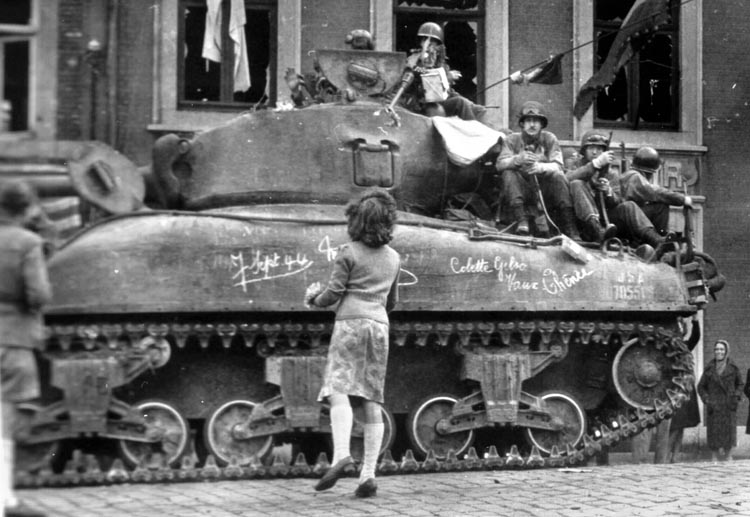
With his crew intact, Pool immediately set about acquiring a replacement tank, also named “In the Mood,” so they could get back in the fight. The second tank was a new M-4 with a longer-barreled 76mm cannon. This gun had better armor-piercing capability than the stubbier 75mm weapon, making it more effective against German armor, though it was still unreliable against the frontal armor of the heavier German models such as the PzKpfw VI Tiger and Panther, except at close range. It was much more effective against the thinner side and rear armor of these tanks: the 76mm could penetrate a Panther’s side armor at 2,000 yards.
A smart tank commander would always attempt to maneuver his vehicle for a shot at the more vulnerable flanks of his opponent. The shorter 75mm gun fired a more effective high-explosive round, so American armored units usually mixed tanks with 75mm and 76mm guns, often placing one tank with a 76mm in a five-tank platoon, the remaining tanks having 75mm weapons. This made sense, as tankers spent more time supporting infantry and attacking enemy positions than fighting other tanks. When enemy armor did appear, it was nice to have the 76mm-armed tank, and Pool’s tank was it for his platoon.
During the fighting near the Falaise Gap on August 7, 1944, Pool was at the front of Task Force Y of 3rd Armored Division’s Combat Command A. The task force commander, Lt. Col. Walter Richardson, listened on the radio as Pool closed with a group of fleeing German troops. “Ain’t got the heart to kill um,” Pool reportedly said, but his statement was followed by the chatter of a .30-caliber bow machine gun as “Schoolboy” Close opened fire. Richardson next heard Pool say, “Watch the bastards run—give it to ‘em, Close.”
Later in the Falaise fighting, Pool was again in the lead near Fromentel, France. Here the second “In the Mood” was destroyed. An article in Yankmagazine from September 1944 states the tank fell to German bombers, but another source states a flight of American Lockheed P-38 Lightning fighter bombers mistook the Americans for the enemy and hit them by mistake. In any event, Pool and his entire crew again survived and soon manned a third “In the Mood,” another M-4 with the 76mm cannon. Before long they were back in combat.
More close calls followed, many of them at night, when combat became more confused and close-range. After a penetration near Origny, France, nightfall came along with an order to “coil” (set up a defensive position). Pool positioned his tank and was just about to call out “Driver, halt!” over the intercom when he spotted a German cannon in the darkness directly ahead. Instead he cried out, “Gunner, fire!” Oller got off a quick shot, his round going right into the German weapon before the enemy gun crew could react.
Another night action occurred at Colombrier, France. While advancing, “In the Mood” almost collided with a German Panther tank in the darkness. The Panther’s crew was quick but inaccurate, getting off two shots, which both missed. Oller’s reply went true, a single round penetrating the turret and detonating ammunition inside. The Panther’s turret blew completely off in a burst of flame and smoke. The luck of “In the Mood’s” crew still held.
After France, the 3rd Armored entered Belgium, where more fighting awaited. At Namur, a small city on the Meuse River, Pool and his men destroyed 16 enemy vehicles in one day, including halftracks, assault guns, and several self-propelled anti-tank guns. Afterward, the advance continued eastward toward the German border, approaching the city of Aachen. Pool was often in the lead, confident and alert, sitting atop “In the Mood.” He rarely “buttoned up” inside his tank; Pool was actually claustrophobic and preferred to either sit on top of the tank or stick out of the commander’s hatch. Most good tank commanders preferred to do this as it provided much better visibility despite the greater risk from enemy fire. “Baby” Richards also preferred to drive with his hatch open; he was once trapped in a tank by a jammed hatch.
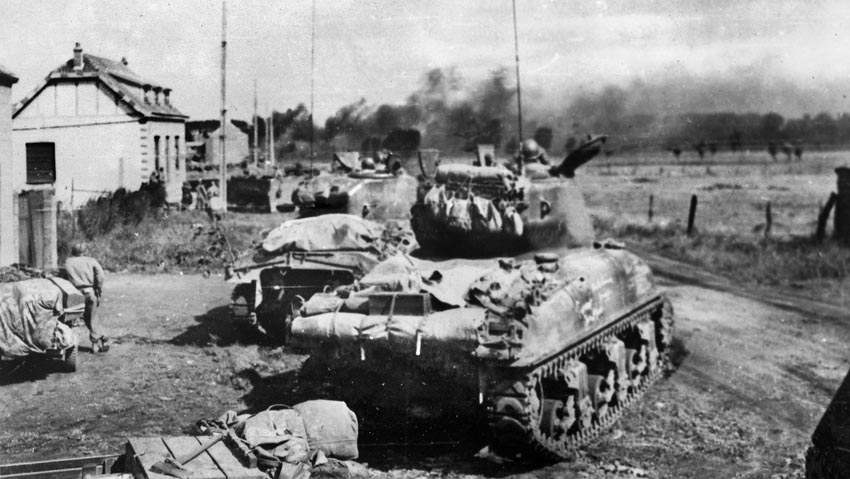
Richards recalled Pool’s preference to lead, as well. He once told a war correspondent, “The men would draw straws to see who would lead the spearhead the next day. Pool would just say ‘Ah’m leading this time,’ and stand there grinning while we cussed him out. But we’d go along just the same. By God, I think we were more scared of Pool than of Jerry!” Richards also told the reporter, “All Pool wanted was to get out ahead of the other tanks so he could kill more Jerries.”
Eventually, Pool’s luck ran out. On September 9, 1944, “In the Mood” acted as flank guard for an attack near Munsterbusch, south of Aachen. Lt. Col. Richardson deliberately placed them on the flank; the whole crew was due to rotate back to the United States for a war bond tour in a few days. Pool recalled his commanding officer’s words: “No spearheading today, Pool. You guys are heroes and I want you going home to momma safe and sound. You take the flank.” Pool remembered those words shortly afterwards as his tank moved along that flank. “Seems he forgot to tell the German troops with the 88 hidden behind the garage door.”
Pool watched that garage door rise, revealing the deadly cannon behind it. Boggs was absent that day, sent to the rear for a hearing check. The replacement loader tried to shove a 76mm round in the breech and jammed it. Unable to fire on the gun, Pool yelled “Back up, Baby!” but it was too late. Richardson, in a tank nearby, saw the tracer of the German round slam into “In the Mood’s” turret. Pool was blown out of the commander’s hatch; he hit the ground trying to run, but his leg folded up under him. A splinter from the enemy round had practically torn off his leg. Pool grabbed a morphine syrette and injected himself before trying to cut off the ruined portion of his leg with his pocket knife.
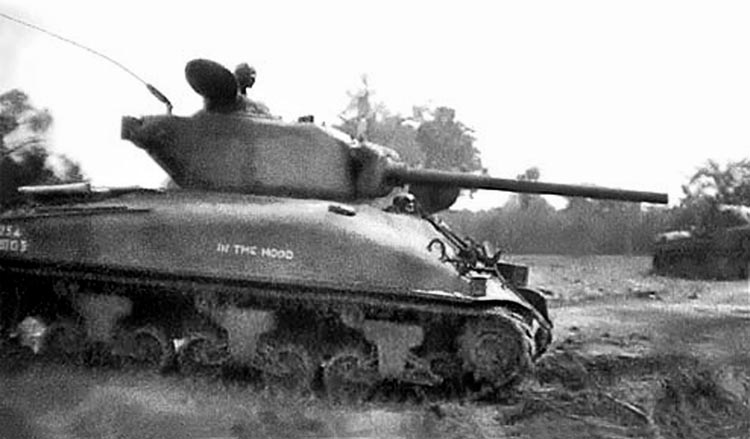
The rest of the crew didn’t know Pool was gone. Richards kept backing the tank when a second round crashed into the hull. The impact sounded like the gong of a massive bell; the stench of burnt powder and a shower of bright sparks filled the tank. As nearby GIs watched, “In the Mood” reached a slope and slowly overturned, coming to a rest almost completely upside down. Oller realized he was wounded when he felt hot blood on his leg. The rest of the crew escaped injury, and all four crawled out of the tank.
Richardson ran up to Pool and gave him another shot of morphine. Moments later medics arrived, gave him yet another shot of morphine, and set about working on his badly bleeding leg. Others attended to Oller. As they put a disoriented Pool on a stretcher for evacuation, he said, “Somebody take care of my tank.” Soon he and Oller were in a hospital. The rest of the crew were matched with a new gunner, and they became Lt. Col. Richardson’s new tank crew.
Pool’s war was over. Along the way he had been twice recommended for the Medal of Honor. In the first case the paperwork was reportedly lost; in the second, the determining authorities decided the act was a combined one of the crew, not just of Pool. His awards include the Distinguished Service Cross, Legion of Merit, Purple Heart, French Croix de Guerre, and the Belgian Fourragere. His shattered right leg was later amputated, and he received a discharge in June 1946.
With the war over, Pool made a go at business, including running a gas station, but in 1948 he received a call to return to active duty along with seven other amputees who possessed needed technical skills. He taught tank mechanics until promoted to warrant officer in 1952. His artificial leg prevented him from being sent outside the United States, so he worked as an ordnance inspector. Pool retired in September 1960, and soon became a preacher. He and his wife Evelyn had seven children, one of whom, Jerry, became a captain in the Special Forces. He was declared missing in action in Cambodia in 1970 but classified as dead in 1978.
As Pool aged, he settled into life in Texas as a teacher before retiring. One day, members of the 32nd Armored Regiment reached out to him, interested in their history. Pool was touched that they remembered him and visited the unit, speaking to the young soldiers about tank combat. When they deployed for Operation Desert Storm, he worried over them until they returned. Soon afterward, he passed away on May 30, 1991.
Author Christopher Miskimon is a regular contributor to WWII History. He writes the regular Books column and served as an officer in the Colorado National Guard’s 157th Regiment.
